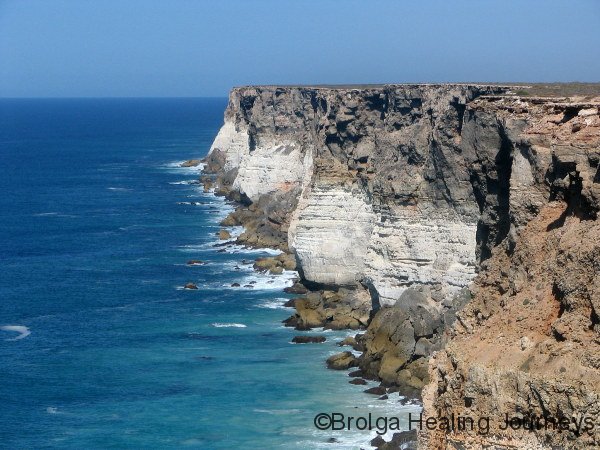Blog 5 – Westward Ho! – March 2008
Our journey across the Great Australian Bight to the Nullarbor Plain and beyond commenced on Australia Day, which seemed to us a very appropriate time to visit such landmarks.
Our first stop was at Cactus Beach, a surf beach famous for its point break (whatever that means). Yes, it did look like a great place for surfing but we were keen to see the Nullarbor cliffs, so we continued on our way. We reached the Great Australian Bight Marine Park which stretches along the coastline of South Australia across the Bight. The cliffs vary from between 60 to 90 metres in height, and rather disconcertingly are often undercut by erosion. The views from the sheer cliffs into the surging Southern Ocean far below were breathtaking.
We pulled out the swags and camped in the coastal heath near (but not too near) the cliffs for several nights at a couple of spots along the Bight. The sunrises, sunsets and times between were beautiful. We watched pods of dolphins playing far below, also watching as they swam in a tight circle herding fish. Peter spotted sea lions on the rocks, their seemingly tiny size reminding us of the height of the cliffs from which we viewed them. At night the Milky Way stood out brilliantly in the skies above, until the salt spray from the ocean would blow across to blur the view.
A couple of lookouts along the Bight were closed due to the danger of the undercut cliffs collapsing. Even those still open to the public remain a little ‘hairy”. You would expect people to behave sensibly near the edge, and even Peter, ever keen on getting just the right camera angle, was pretty cautious. However, despite clear warning signs at every lookout and requests for parents to control their children near the cliffs, we were astounded by the way some people behaved. We saw a father walk his son, about 10 years old, to the very edge of a 70 metre cliff, and have his son outstretch his arms and arch backwards over the edge, for a photo with the Southern Ocean in the background. If that wasn’t bad enough, the ground the boy was standing on was thin and completely undercut by erosion, and a strong wind was blowing from inland out across the cliff. One slip and the kid would have been gone, and in all probability the parents would have sued the government. Nirbeeja couldn’t bear to watch and walked over to inform them that the boy was standing on the edge of an undercut ledge. All she got was a supercilious smile.
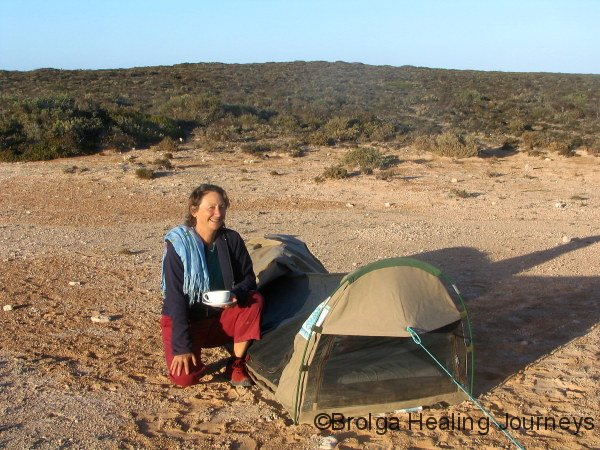
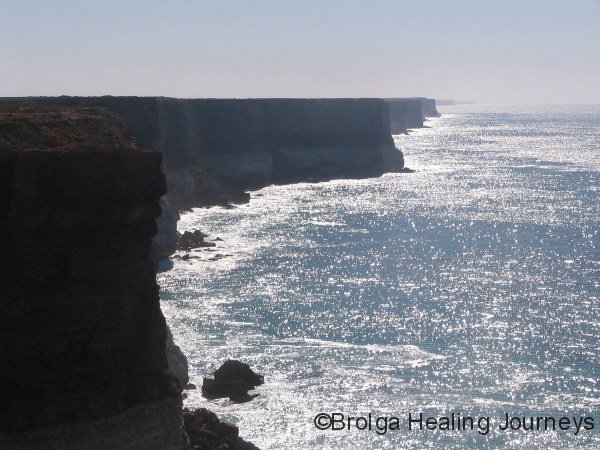
Still, we had some really enjoyable, and less anxious, encounters along the Nullarbor cliffs. Our first was with the Flag of Freedom bus, the brainchild of Simon, a whitefella who is championing Aboriginal rights. His bus is covered with interesting poetry and art works from the various Aboriginal communities he has visited on his long pilgrimage around the country. We also met an English couple, Terry and Claire, in their bus Tilly, at one of the lookouts. We share a love of wildlife and travel with them, and hit it off right away. We have continued to catch up with them as we headed into WA, sharing many adventures with them on our journey (more about those later).
As we approached the border with Western Australia the temperature soared, reaching 43 degrees for several days before a cool change came through. We stopped at the border quarantine checkpoint and parted with our goodies (all fresh fruit and vegetables and even our honey – much to Nirbeeja’s consternation) and then drove into Eucla, where we did some sightseeing in the blistering heat. The area is famous for its sand-dunes and the historic Eucla Telegraph station, now largely immersed in those very dunes.
The scenery along the Nullarbor was surprisingly interesting. Given its name Nullarbor – derived from “null” meaning zero, and “arbor” meaning tree ie “no trees” – we expected hours of nothing on our drive, but instead encountered interesting vegetation along the entire stretch of highway. Saltbush gave way to coastal heath, followed by mallee forests. The true Nullarbor Plain lies 100 or more kilometres inland from the highway and most probably features far more of the truly treeless plains. The crossing of the Nullarbor Plain seems etched into the Australian consciousness as something one doesn’t do lightly, but our experience of the crossing was truly enjoyable. Nirbeeja first crossed the Nullarbor over 30 years ago, and recalls a dirt road and arduous crossing; how things have changed. Modern cars and a good road have helped make the crossing faster and safer. However, they probably mask the fact that, even today, if something does go wrong you are still a long way from help. As a reminder, every hundred or so kilometres along the road you encounter a Flying Doctor runway; which is just fine, until you realize that the highway doubles as the runway.


We camped overnight near Madura, 200kms or so west of Eucla, before embarking upon the trip to Norseman, regarded as the end of the Nullarbor crossing. En route we travelled through Cocklebiddy, with its abundance of Wedge-Tailed Eagles, then along the 90 mile straight (which has a better ring to it than the 146.6km straight as it is now known). We sat back and relaxed, but both somehow resisted the temptation to play cards or have a snooze. Unfortunately, dead kangaroos litter this stretch of highway; in some places bodies are dotted along the highway every 50 metres or so. It would be perilous to drive along these roads at night.
We arrived in Norseman, a town reliant largely on mining for its survival, and were pleasantly surprised to find it surrounded by stands of Salmon Gums; tall, stately eucalypts named after the lovely colour of their trunks. From Norseman we headed south to Esperance, along the way noticing an abundance of flowering trees. Some eucalpyts had hand-sized clusters of crimson flowers, while other trees (the Christmas tree, we have since learned), featured brilliant golden flowers.
We reached Esperance, the first major town since leaving Ceduna, in cool, wet conditions, quite a change from a few days previous on the Nullarbor. The weather prevented Esperance from showing us her prettiest face, but Peter forgave all when he discovered the best coffee, at the Coffee Cat on the Tanker Jetty, since leaving the Antz Pantz cafe at home. Nirbeeja eventually dragged Peter away from the coffee stall, and we headed east along the coast to the Cape le Grand National Park.
Our first impression on entering the park was that we were in the land that time forgot. The weather was cool and misty, and huge tracts of unspoilt coastal vegetation gave rise to dramatic granite outcrops and domes, worn smooth over time by the wild weather off the southern ocean. We later learned that the region was once under water (some 40 million years ago) and that the initial wearing of the domes took place under water when ancient sea levels were some 300 metres higher than at present.
Cape Le Grand National Park has so much to recommend. Despite wet, windy weather for a couple of days, we were struck by the beauty of its beaches, such as Lucky Bay, Thistle Cove and Hellfire Bay. When the sun appeared, we saw their full beauty; pure white sands that squeak under foot, aqua and turquoise waters, an abundance of flowering plants, all this with the dramatic backdrop of huge granite domes. Wow!
The following photos may give you some idea of the flowers we saw. We can only imagine what it is like in springtime!
We went on many of the walks around the park from our campsite at Lucky Bay, to Rossiter Bay, Thistle Cove and up Frenchman Peak. The peak resembles a beret, but upon climbing we discovered that the cap covers a huge cavern.
The park also provides a home to an abundance of wildlife. New Holland Honeyeaters were everywhere (almost to the point where we tired of them), we spotted sea lions lazily swimming around the rocks of Lucky Bay, had to tiptoe around goannas that refused to leave the walking paths, were entertained by small lizards scuttling and jumping around the rocks, and were stopped in our tracks by a 1 ½ metre Dugite (a highly venomous, but fortunately fairly shy, relative of the tiger snake).
Each afternoon offshore winds would come up and buffet the campsite, to the point where it seemed someone was trying to throw themselves through the canvas walls of the kitchen annex! But then the sun and calm conditions would reappear, and so did Claire and Terry, our new friends. They reintroduced Peter to snorkelling, and Nirbeeja had her first experience with goggles, flippers and snorkel; a pastime we have both since taken up enthusiastically after a few initial splutters.
After a nervewracking introduction to sand driving in the deep soft sands of Coffin Bay National Park (see last blog), Peter bravely ventured onto the sands of Lucky Bay in the car, safely making it to the end of Lucky Bay beach and back. Hopefully the first of many such drives in future.
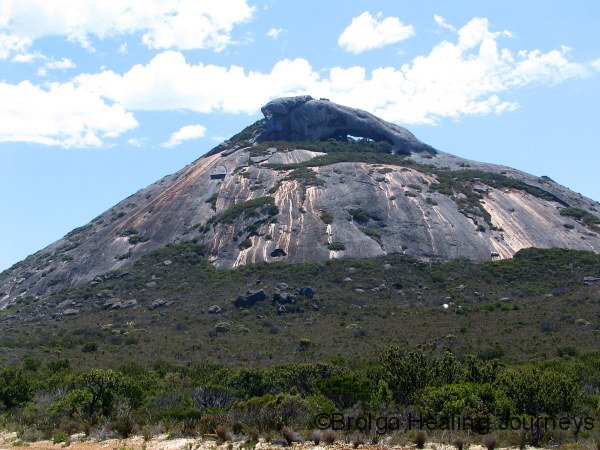
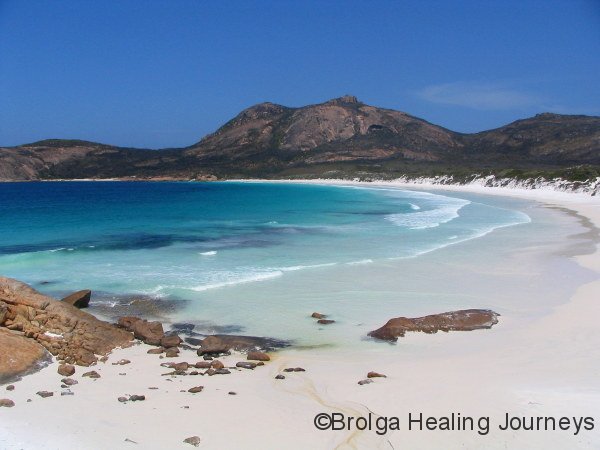
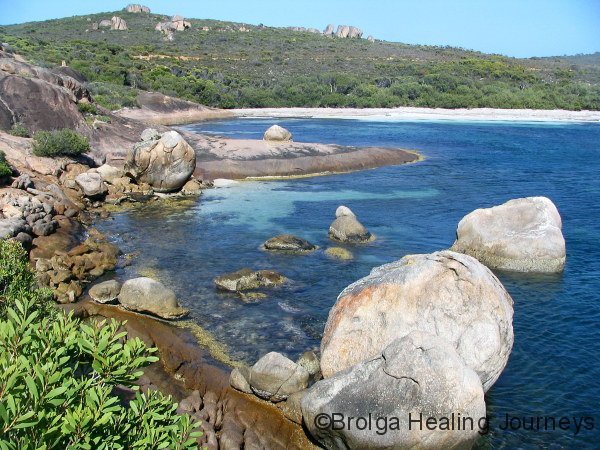
We left Cape Le Grand National Park, as usual sad to leave such a beautiful place, but content in the knowledge that somewhere just as special probably awaited around the corner. After stopping briefly in Esperance to get supplies (and snorkelling gear, having been inspired by our recent attempts), we camped overnight at a free camp beside the highway. Next day we continued the long drive towards Albany, stopping off to check out the relatively small, and little known, Waychinicup National Park. The park takes its the name from the local Aboriginal language, and means ‘the place that puts emus into being’ – though we didn’t see any there – and features a glorious unspoilt inlet nestled in hills dotted with huge granite boulders. The decision to stay for a couple of nights was not difficult.
We took to the inlet in the afternoon to test our snorkelling gear (yes, it worked, and we saw some fish), and then used our Sat phone to ring Claire and Terry, who had travelled on to Albany, leaving them a message to say we had found a lovely spot. We didn’t say where (silly us), but said we’d call again the next day. We were stunned when, just on dusk on our first night there, we heard the familiar sound of their bus Tilly come down the track. To put their efforts at finding us into context, they had visited 6 or 7 different campsites on the 50 kms up the coast from Albany, before reaching us. Many wines followed as we celebrated our re-union, and a great day was topped off by a visit to our campsite by some Brush-Tailed and Ring-Tailed Possums, and a Quenda, the local name for the Southern Brown Bandicoot. One Brush-Tailed possum in particular was very friendly (or should we say humanized) and did his level best to help himself to our food.
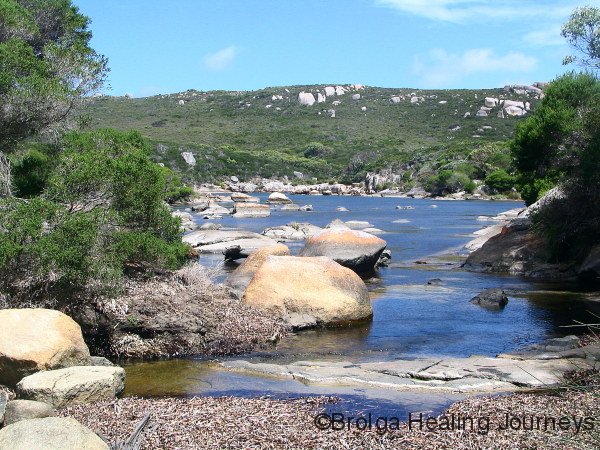
We continued our wanderings westward, accompanied by Terry & Claire, first visiting Albany in time for their Farmers’ Markets, then taking in the scenery of the local Torndirrup National Park, with attractions such as the Blow Hole (which made the occasional loud roar but didn’t blow as such), the Gap, and the Natural Bridge.
Looking for somewhere to camp, we moved onwards to Shelley Beach in West Cape Howe National Park. Here the campsite was virtually on the sandhills of the dramatic beach with its wild surf, nestled beneath steep hills and granite cliffs. Each morning all our gear was dripping with sea-spray. This was another top spot (we are quickly running out of superlatives for the places we have stayed). The surf and rips were too strong to swim in safety, but simply standing thigh deep proved sufficient to give us a good workout and/or help us to cool down after a walk. Claire was bowled over a couple of times by large waves and washed right up onto the beach. A few days here allowed us to venture off on the various bushwalking trails and to indulge in more wildlife spotting, notable of which was the White-Tailed Black Cockatoo, and an enormous male western grey kangaroo encountered by Peter on one of his walks. White-Breasted Robins, Southern Emu Wrens and Western Rosellas were also encountered there.
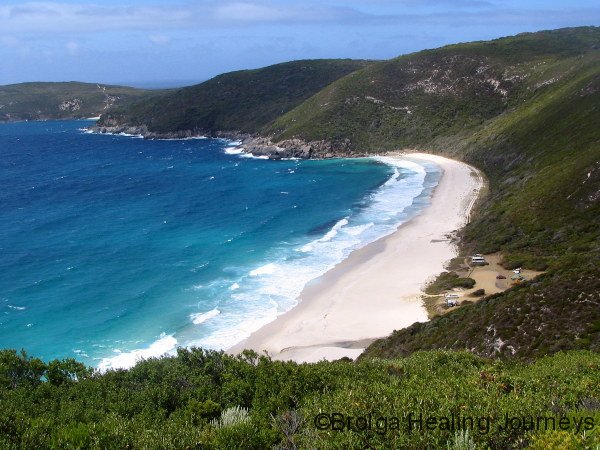
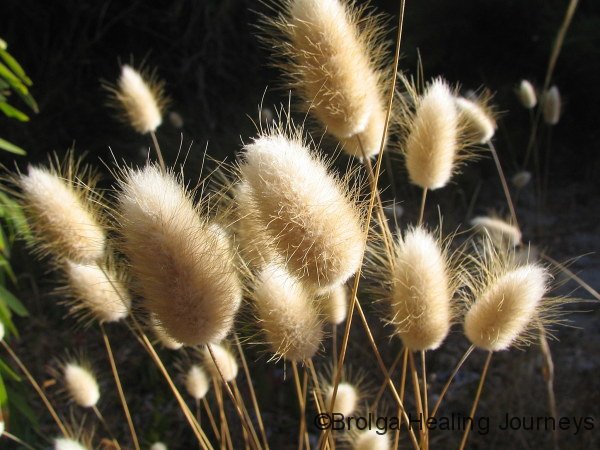
Leaving Shelley Beach, we passed through the lovely town of Denmark, set in rolling hills, beside a tranquil river, in an area marking the beginnings of the majestic trees for which the south western region of WA is famous. “I could live here”, we stated in stereo on arrival in Denmark. We drove on to Parry Beach, a council run camping ground recommended to us by a couple we met at Waychinicup. Our first impression was one of shock – at the sheer number of vans camped there. We were used to having places entirely to ourselves, or almost so. But we decided to stay, and were fortunate to find a camping spot under melaleucas at the end of the park, all to ourselves. The place grew on us the longer we stayed. We used Parry Beach as a base to explore the region, visiting William Bay National Park, a couple of local wineries, a honey/mead producer (which for some reeason appealed to Nirbeeja!) and an alpaca and animal farm where we patted a koala and witnessed the birth of an alpaca, which was standing, albeit tentatively, on her wobbly little legs within 15 minutes of her birth.
At William Bay National Park we swam and snorkeled in Greens Pool, a large natural pool protected from the southern ocean. The water was pretty icy but we were fortunate to see some beautiful fish, notably giant angel fish and another large striped fish with huge pink lips. Nearby we also swam at Elephant Rocks, aptly named because it contains large granite outcrops with an uncanny resemblance to a herd of elephants bathing in the ocean.
We had another wildlife encounter to add to our experiences at Parry Beach, when a beautiful little Spotted Thighed Frog took a liking to our kitchen area; twice we arose in the morning to find him nestled up beneath our dinner plates.
Leaving Parry Beach, we traveled to the Walpole region and were awed by the giant Tingle Trees on the beautiful Tree top walk in the Valley of the Giants. Here we wandered among the canopy some 40 metres above the ground. Light rain was falling but that seemed somehow appropriate, bringing out the rich scents of the forest. You couldn’t help but feel alive, taking deep breaths of the oxygen enriched air. Walking among trees up to 400 years old filled one with a sense of reverence. Another ground-level walk took you to, and through, the base of the Red Tingle Trees. The shallow rooted Red Tingle, which only grows in the Walpole region, develops a hollow base at it ages. Red Winged Fairy Wrens flitting through the undergrowth completed the experience.
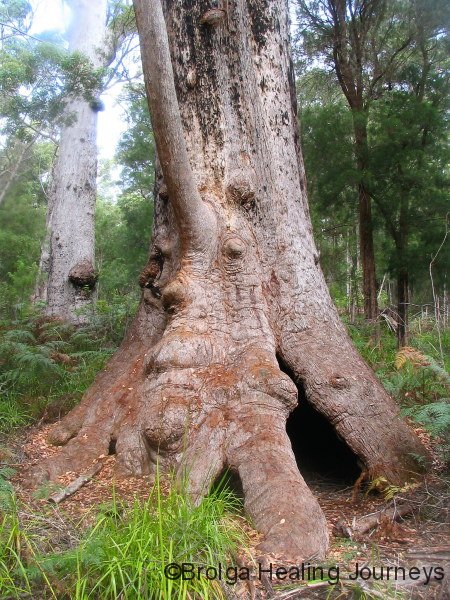
From Walpole we travelled with Terry and Claire to the D’Entrecasteaux National Park, camping at Crystal Springs – how could we resist stopping at a place with such a name. It proved to be a beautiful setting amongst Peppermint Trees, a species of eucalypt. Interestingly, honey made from the blossoms of Peppermint Trees has a strong ‘high note’ flavour, reminiscent of Leatherwood honey from Tasmania.
The park is rich in birdlife and from our campsite we viewed (and heard) Kookaburras, Crows, Black Cockatoos, Scarlet Robins (our first sighting), Fantails and Scrub and Red Winged Fairy Wrens.
On one drizzly day the boys walked 9km each way along a sandy track to Long Point and were rewarded by scenes of wild surf and dramatic headlands. Massive waves from the Southern Ocean were pounding the coastline; not a place to go swimming.
The overcast weather continued, so we toured the region, driving to Mandalay Beach, named after the ship wrecked on the beach which emerges from the sand every decade or so when the sands shift from the beach, then inland to Fernhook Falls in the Mount Frankland National Park. We were dazzled en route by the iridescently coloured Swamp Bottlebrushes, with whole fields of them in bloom; a gorgeous sight after rain.
We also bushwalked through magnificent old growth forest in the Mount Clare region – a highlight of trip. Giant Karri and Tingle Trees towered above us, while Golden Whistlers, Robins, Western Rosellas and and Ringnecks constantly entertained us as they flew through the trees. The Karri trees, which had become evident for us for the first time on our travels, grow to enormous heights.
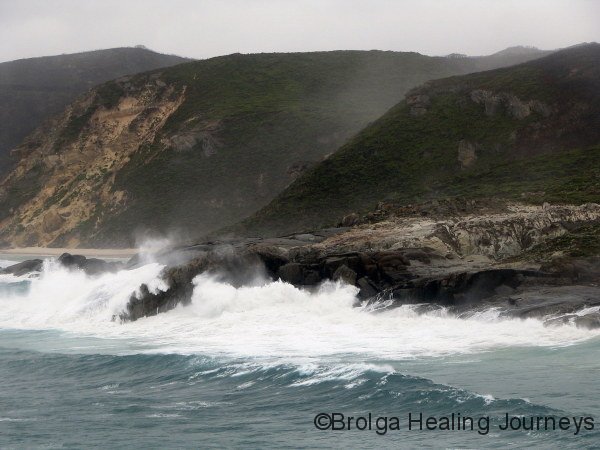
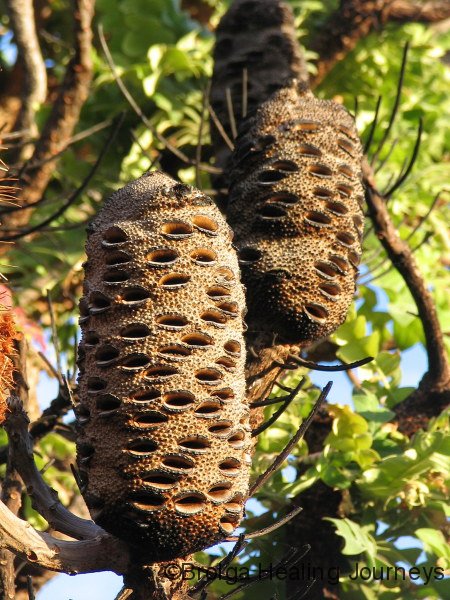
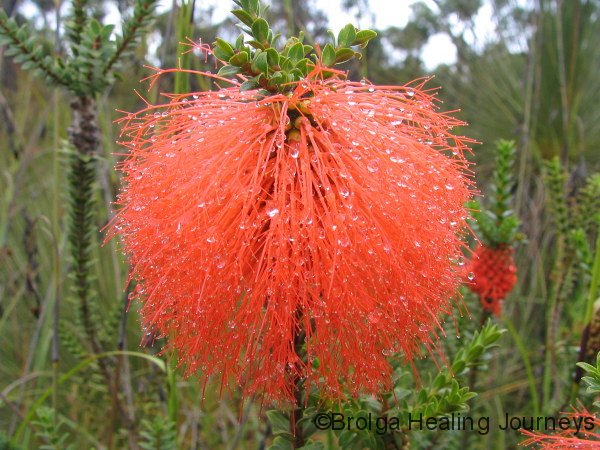
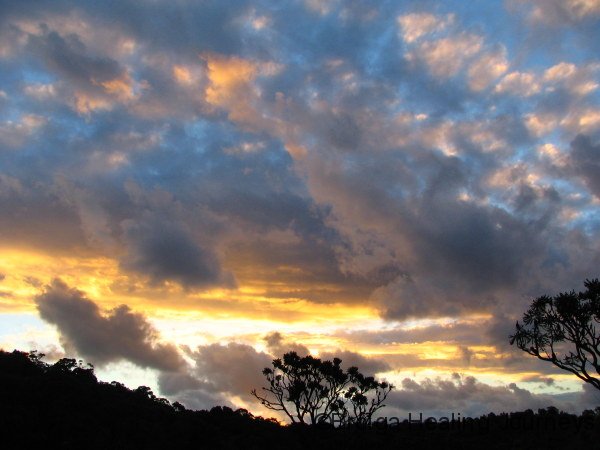
We travelled west, passing through Shannon National Park, and Northcliffe, to the Warren National Park in the Pemberton region. Warren National Park contains unlogged, old growth Karri, Marri and Jarrah trees, some soaring to more than 70 metres in height. The roads pass through breathtaking scenery, making it a challenge for the driver to keep their eyes on the road. The forests are home to abundant birdlife, but the trees are so tall the parrots and lorikeets in the upper canopy are virtually invisible from the ground.
In the days before satellite and radar monitoring of bushfires, local foresters monitored fire conditions from watch towers erected in the highest trees. Around 15 of these towers are still used, and three are open to the public. To be honest, we are astounded, though pleasantly surprised, that they are still open in our time of public liability insurance and litigation. The tallest tower, known as the Bicentennial Tree, in the Warren National Park, reaches 75 metres above the ground. You ascend to the tower up a series of metal spikes driven into the tree trunk to form a spiral staircase of sorts. They certainly test your fear of heights, when you realize that there is daylight between each spike and the ground far below. Peter has what he calls a healthy aversion to falling from great heights, and climbed up about 3 metres before stating that there was no way he could go further, and climbed down. Nirbeeja, however, with the prospect of seeing parrots in the upper canopy, shot up the spiral “stairs” like a goanna up a tree, to the 25 metre rest station. Peter, psyched himself up, then climbed up to the same point, where he trembled like a leaf, before descending to the safety of the ground. Nirbeeja then bravely climbed up to the top of the 75 metre tower, no mean feat. Many people simply stand at the bottom of the tree and refuse to even begin the climb. And finally, in an effort to confront his fears head on, Peter also climbed to the top of the tree. At the top, we were rewarded with views into the far distance, and loved watching parrots feeding so far above the ground.
The climb is strenuous, as Nirbeeja discovered towards the end of her descent when her thigh muscles turned to jelly. She safely reached the ground, but spent the next couple of days hobbling around as payment for her adventure. Peter showed just how much he had conquered his fears by climbing the Gloucester Tree the following day, and the Diamond Tree the day after that, both at around 60 metres, completing the ‘set’ tree tower climbs.
We spent a number of days in the gorgeous Pemberton region, camping firstly with Terry and Claire at the Big Brook arboretum, then by ourselves in Warren National Park; both magnificent campsites nestled amongst giant Karri trees. We must stress that we were careful not to camp directly under the trees, because they are in the habit of dropping huge limbs in the still of hot summer days. The sound of enormous explosions echoing through the valley as branches came down vindicated our decision to adopt this safety first camping approach. Both camps feature abundant wildlife, Big Brook proving a haven for White Tailed Black Cockatoos and Kookaburras (an introduced species in WA) and lots of wrens, and Warren National Park also allowing us to meet its brush tailed and ring tailed possums, frogs, bats and even an owlet nightjar. Oh, and it had the largest and most voracious march flies we have met on our travels.
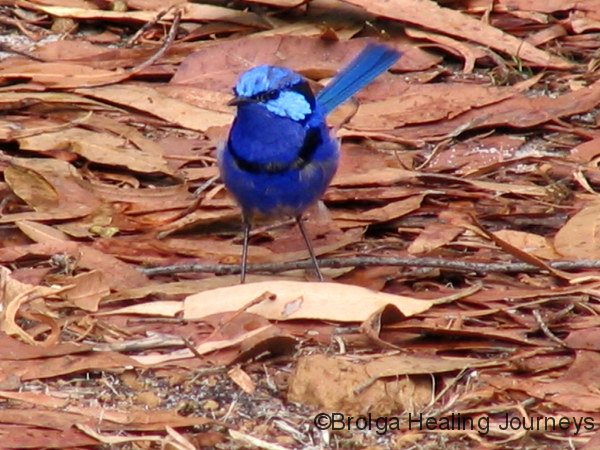
With a rendezvous planned for end February in Perth with our friends Richard and Lisa from home, we set off northwards, camping one final night at Workers Pool in St Johns Conservation Park near the lovely little village of Nannup. Workers Pool is beautiful – a lovely natural swimming hole that helped us to cool down on a stinking hot day, lots of birdlife and possums – in fact, lots and lots of possums who did their best to keep us awake all night! They were around the camper, on the camper, under the camper, and on the canvas roof above the bed; very cute but not at 3am.
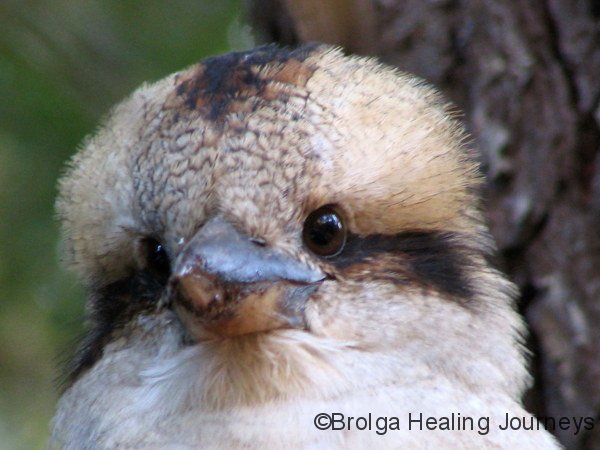

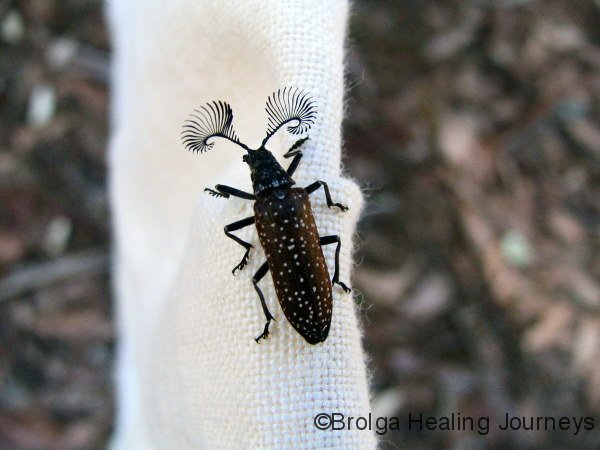
We write this blog now from the Crowne Plaza Hotel in Perth (thanks everyone at the Hierophant for the gift vouchers), looking out our window to views across the Swan River. We were worried about how we would adjust to a couple of nights in a hotel after seven months of camping, largely in wilderness areas, but we are pleased to report that we very quickly grew accustomed to the luxury!
Tonight we were treated to a fireworks display as part of WA’s Labour Day weekend celebrations, although we prefer to think it was organized in honour of the arrival of the Wilmots and us. We spent the morning wandering around the inner city, admiring the views, and enjoying the lovely parklands in the heart of the city. Richard and Lisa arrived this afternoon and we are all heading off tomorrow to the Margaret River region. All is well with the world.
Till next time.
Cheers
Peter & Nirbeeja
1 March 2008
